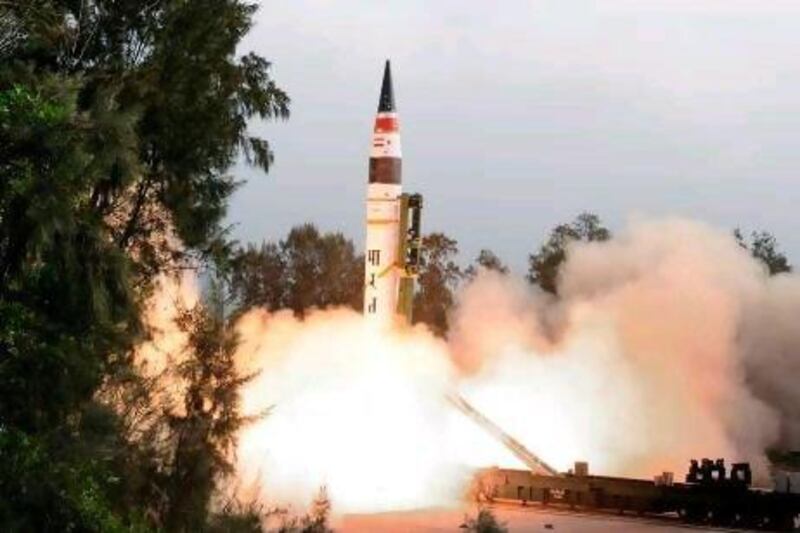NEW DELHI // India launched a missile yesterday capable of reaching Beijing and Eastern Europe, propelling it into an elite group of nations able to carry nuclear warheads across continents.
Television footage showed the missile, which has a range of 5000 kilometres, taking off from Wheeler Island, off the coast of Orissa state.
The 17-metre tall Agni-V missile hit its target in the Indian Ocean 20 minutes after the launch yesterday, according to the Defence Research and Development Organisation (DRDO) of India. Only the UN Security Council permanent members – China, France, Russia the United States and Britain – along with Israel, are believed to have such long-range weapons.
The launch strengthens India's position with China, its neighbour and regional rival, analysts said. But India's military technology still lags behind China's. The range of the Agni-V is half that of missiles developed by China, the US and Russia.
Beijing’s possession of long-range ballistic missiles is believed to be the main driving force behind India’s missile programme.
“India has achieved deterrence parity with China,” said Bharat Karnad, a security analyst with the Center for Policy Research in New Delhi.
China is well aware that after the missile launch, India “will feel far more confident in its dealings with China,” he said. “The Agni-V makes India a greater regional power capable of dealing with China on an equal basis.”
China yesterday downplayed the significance of the launch.
“China has taken note of reports of India’s missile launch,” said the foreign ministry spokesman Liu Weimin. “China and India are both big emerging countries. We are not rivals but cooperation partners.”
The Global Times, which is owned by the Chinese Communist Party's main mouthpiece the People's Daily, struck a less conciliatory tone, warning India was being "swept up by missile delusion".
In an editorial, the newspaper, said yesterday that India “should not overestimate its strength”.
“Even if it has missiles that could reach most parts of China, that does not mean it will gain anything from being arrogant during disputes with China,” the newspaper said.
India and China fought a war in 1962 and continue to nurse a border dispute. In recent years the Indian government has fretted over China’s enhanced military presence near the border.
While India labelled the Agni-V an intercontinental ballistic missile, it is more correctly classified as an intermediate range ballistic missile, Mr Karnad said. The American Minuteman, the Russian Tupol and the Chinese Dong-Feng all have ranges of about 10000km.
Despite the missile test, India remains a “secondary competitor” militarily with China, said Alan Chong, an Asia security analyst at the S Rajaratnam School of International Studies in Singapore, with the United States remaining Beijing’s primary focus.
“There’s this game of one-upmanship [between India and China]. You have to see this missile against this background,” he added.
“I wouldn’t be confident India definitely has this capability until this missile is fully deployed … meaning there’s a rocket unit in the Indian armed forces dedicated to operating this type of missile. China has got everything from short to intercontinental right now.”
India has been keen to emphasise that the missile is purely for defensive purposes. “Today’s launch represents another milestone in our quest for
“The missile is part of a long-term strategy to attain security through deterrence,” said Mr Pai. “It deters powers that have interests inimical to India from acting in ways that undermine our national security.”
The Agni-V is a solid-fuel, three-stage missile designed to carry a 1.5-tonne nuclear warhead. It was built mainly with Indian-made technology at a reported cost of 25 billion rupees (Dh1.79bn). It can be moved across the country by road or rail and can be used to carry multiple warheads or to launch satellites.The missile, named after the Sanskrit for “ignite”, will need four or five more trials before it can be inducted into India’s arsenal at some point in 2014 or 2015, Indian officials said.
India is also close to completing a nuclear submarine that will increase its ability to launch a counter strike if it were attacked.
The test came just days after North Korea’s failed rocket launch, but sparked none of the same global condemnation aimed at Pyongyang.
India is not a signatory to the Nuclear Non-Proliferation Treaty, designed to prevent the spread of nuclear weapons. The 2008 Indo-US civilian nuclear agreement allowed it to resume imports of nuclear fuel, a tacit acceptance of India’s nuclear weapons arsenal.
Pakistan has nothing additional to fear from the Agni V, analysts said as both countries have long had the ability to launch nuclear weapons at each other’s capitals.
sbhattacharya@thenational.ae
* With additional reporting by Daniel Bardsley in Beijing, Reuters and the Associated Press
Follow
The National
on
[ @TheNationalUAE ]
& Surya Bhattacharya on
[ @SuryatapaB ]





